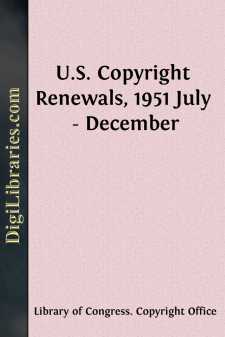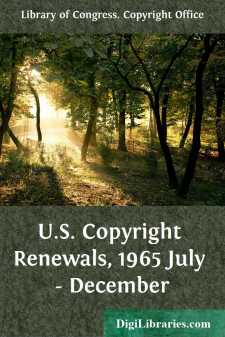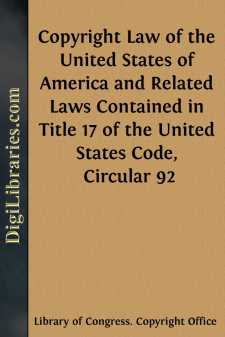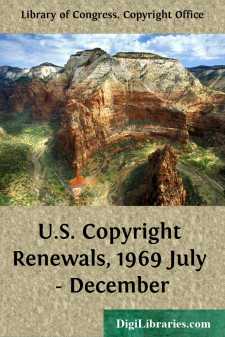Categories
- Antiques & Collectibles 13
- Architecture 36
- Art 48
- Bibles 22
- Biography & Autobiography 813
- Body, Mind & Spirit 142
- Business & Economics 28
- Children's Books 16
- Children's Fiction 13
- Computers 4
- Cooking 94
- Crafts & Hobbies 4
- Drama 346
- Education 46
- Family & Relationships 57
- Fiction 11829
- Games 19
- Gardening 17
- Health & Fitness 34
- History 1377
- House & Home 1
- Humor 147
- Juvenile Fiction 1873
- Juvenile Nonfiction 202
- Language Arts & Disciplines 88
- Law 16
- Literary Collections 686
- Literary Criticism 179
- Mathematics 13
- Medical 41
- Music 40
- Nature 179
- Non-Classifiable 1768
- Performing Arts 7
- Periodicals 1453
- Philosophy 64
- Photography 2
- Poetry 896
- Political Science 203
- Psychology 42
- Reference 154
- Religion 513
- Science 126
- Self-Help 84
- Social Science 81
- Sports & Recreation 34
- Study Aids 3
- Technology & Engineering 59
- Transportation 23
- Travel 463
- True Crime 29
Copyright Basics
Categories:
Description:
Excerpt
WHAT IS COPYRIGHT?
Copyright is a form of protection provided by the laws of the United States (title 17, U.S. Code) to the authors of "original works of authorship", including literary, dramatic, musical, artistic, and certain other intellectual works. This protection is available to both published and unpublished works. Section 106 of the 1976 Copyright Act generally gives the owner of copyright the exclusive right to do and to authorize others to do the following:
+ *To reproduce* the work in copies or phonorecords;
+ To prepare *derivative works* based upon the work;
+ *To distribute copies or phonorecords* of the work to the public by
sale or other transfer of ownership, or by rental, lease, or
lending;
+ To perform the work publicly, in the case of literary, musical,
dramatic, and choreographic works, pantomimes, and motion pictures
and other audiovisual works;
+ *To display the copyrighted work publicly*, in the case of literary, musical, dramatic, and choreographic works, pantomimes, and pictorial, graphic, or sculptural works, including the individual images of a motion picture or other audiovisual work; and
+ In the case of *sound recordings, to perform the work publicly* by means of a *digital audio transmission*.
In addition, certain authors of works of visual art have the rights of attribution and integrity as described in Title 17, Chap 1, Section 106a (Circular 92) of the 1976 Copyright Act. For further information, request "Copyright Registration for Works of the Visual Arts" [http://www.loc.gov/copyright/circs/circ40.pdf].
It is illegal for anyone to violate any of the rights provided by the copyright law to the owner of copyright. These rights, however, are not unlimited in scope. Title 17, Chap 1 of the 1976 Copyright Act establish limitations on these rights. In some cases, these limitations are specified exemptions from copyright liability. One major limitation is the doctrine of "fair use", which is given a statutory basis in Title 17, Chap1, Section 107 of the 1976 Copyright Act. In other instances, the limitation takes the form of a "compulsory license" under which certain limited uses of copyrighted works are permitted upon payment of specified royalties and compliance with statutory conditions. For further information about the limitations of any of these rights, consult the copyright law or write to the Copyright Office.
———————————————————————————————————— WHO CAN CLAIM COPYRIGHT
Copyright protection subsists from the time the work is created in fixed form. The copyright in the work of authorship *immediately* becomes the property of the author who created the work. Only the author or those deriving their rights through the author can rightfully claim copyright.
In the case of works made for hire, the employer and not the employee is considered to be the author. Title 17, Chap 1, Sec. 101 of the copyright law defines a "work made for hire" as:
+ (1) a work prepared by an employee within the scope of his or her employment; or
+ (2) a work specially ordered or commissioned for use as:
+ a contribution to a collective work
+ a part of a motion picture or other audiovisual work
+ a translation
+ a supplementary work
+ a compilation
+ an instructional text
+ a test
+ answer material for a test
+ a sound recording
+ an atlas
if the parties expressly agree in a written instrument signed by them that the work shall be considered a work made for hire…....












